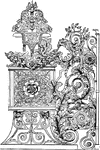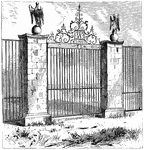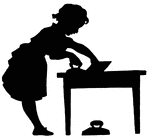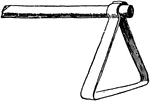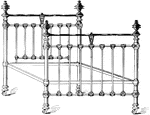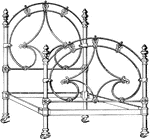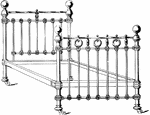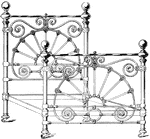
Ailette
"A plate of iron worn over the mail to protect the shoulders of a man-at-arms, before the introduction…
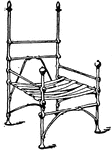
Frame of Medieval Arm-Chair
The Frame of Medieval Arm-chair was made of iron with no drapery included.
Beacon
"Beacons in exposed situations are constructed sometimes of stone, and cement-concrete or cement-rubble,…

Blast Furnace
A blast furnace measuring 42 feet high and 15 feet across that contains 4356 cubic feet of space.

Blast Furnace
A blast furnace measuring 47.5 feet high and 16.5 feet across that contains 6174 cubic feet of space.

Blast Furnace
A blast furnace measuring 55 feet high and 16 feet across that contains 7175 cubic feet of space.

Blast Furnace
A blast furnace measuring 58 feet high and 17 feet across that contains 8000 cubic feet of space.

Blast Furnace
A blast furnace measuring 60 feet high and 20 feet across that contains 12778 cubic feet of space.
Blast Furnace
A blast furnace measuring 75 feet high and 16.5 feet across that contains 11983 cubic feet of space.

Blast Furnace
A blast furnace measuring 80 feet high and 20.5 feet across that contains 15500 cubic feet of space.
Blast Furnace
A blast furnace measuring 95.5 feet high and 16 feet across that contains 15050 cubic feet of space.
Blast Furnace
A blast furnace measuring 95.5 feet high and 22 feet across that contains 25940 cubic feet of space.
Blast Furnace
A blast furnace measuring 95.5 feet high and 24 feet across that contains 28950 cubic feet of space.

Blast Furnace
A blast furnace measuring 85 feet high and 25 feet across that contains 26000 cubic feet of space.

Blast Furnace
A blast furnace measuring 90 feet high and 30 feet across that contains 41149 cubic feet of space.
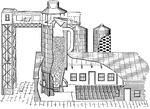
Blast Furnace for Cast Iron
"Iron ores are smelted in a blast furnace which is operated in a manner similar to that employed in…

Ironing Board
Most ironing is done on an ironing board, a small, portable, foldable table with a heat resistant top.…

Bunsen Burner
"...gas lighted above an iron gauze (a, Fig. 11) does not catch fire below the gauze because the heat…
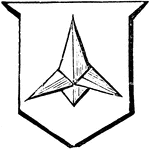
Caltrop
"Argent, a caltrop proper. CALTROP. An iron instrument made to annoy an enemy's cavalry. They were formed…
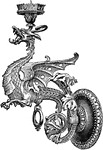
Candle-Pricket
"Wrought Iron Candle-Pricket; late 15th-century. Florentine work." —The Encyclopedia Britannica,…
Center of Inertia
"But, suppose the same bar or iron, whose inertia was overcome by raising the centre, to have balls…

Chlorination Barrel
The chlorination process in gold extraction employs large vats or revolving barrels, the material inside…
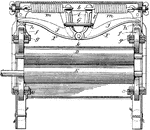
The Laundry Aided Clothes Wringer
This clothes wringer is a mechanical laundry aid consisting of two rollers connected by cogs, powered…

Collecting Top
"Prior to the introduction of the cup and cone, a form of tunnel-head in which no valve or cone exists…
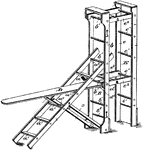
Combination Step Ladder, Clothes Rack, and Ironing Board
This is a combination step ladder, clothes rack, and ironing board. A step ladder is hinged in the middle…
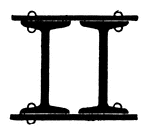
Compound Riveted Girder (side by side)
A compound riveted girder is designed to bear a large load in a building or bridge, and is made of either…

Compound Riveted Girder (Vertical)
A compound riveted girder is designed to bear a large load in a building or bridge, and is made of either…
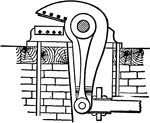
Cropping Shears
"An old arrangement known as cropping shears, still in use at many iron-works, where early appliances…

Iron Age horse Cultivator
An Iron Age horse cultivator, good for working crops which require a horse cultivator. The levers can…
Electromagnet
"An electromagnet is a bar of iron magnetized by an electric current, substantial as just shown." —…

Elongation in the Direction of the Orthogonal Axis
In some cases, the elongation of a crystal may be in the direction of the orthogonal axis, whose position…

Expansion of Solids
"The expansion of solids by heat is clearly shown by the following experiment: m represents a ring of…

Ferrie's Furnace
"A peculiar furnace, known as Ferrie's self-coking furnace after the name of its inventor, in which…
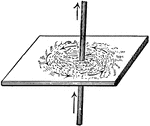
Magnetic Field Due to Current
"Around a vertical conductor carrying a heavy current, place a peice of paper and sprinkle iron filling…
Combined Wood and Iron Flume
"The section of the flume is usually rectangular, but it may be of a V shape, and occasionally, as in…

Water Fountain
This water fountain is made out of iron in the form of two open flower shapes, on top of each other.

Genouillère
"Genouillère, middle of 13th century. The knee-piece, of hammered iron, introduced toward the…
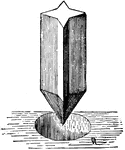
Go-Devil
"Go-Devil. A device for exploding a dynamite cartridge in an oil-well ... A pointed piece of iron dropped…

Golf Clubs
"Golf clubs. 1, Driver; 2, brassie; 3, putter; 4, cleek; 5, iron; 6, niblick." -Foster, 1921
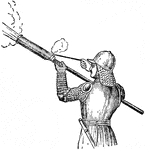
Hand-Gun
"The hand-gun was used by both infantry and cavalry; it consisted of a simple iron or brass tube with…

Difference of Heat Transference Between Copper and Iron
"Place a bar of iron and a similar one of copper end to end so as to be heated equally by the flame…
Howard's Plough
"The plough is composed of two strong iron frames balanced upon four wheels, and crossing each other…
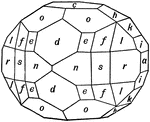
Hypersthene
This figure exhibits a combination occurring on the ferro-magnesian meta-silicate, Hypersthene. Forms:…

Iron
Tangrams, invented by the Chinese, are used to develop geometric thinking and spatial sense. Seven figures…

Iron
Tangrams, invented by the Chinese, are used to develop geometric thinking and spatial sense. Seven figures…

Iron
Tangrams, invented by the Chinese, are used to develop geometric thinking and spatial sense. Seven figures…

Iron
Tangrams, invented by the Chinese, are used to develop geometric thinking and spatial sense. Seven figures…


